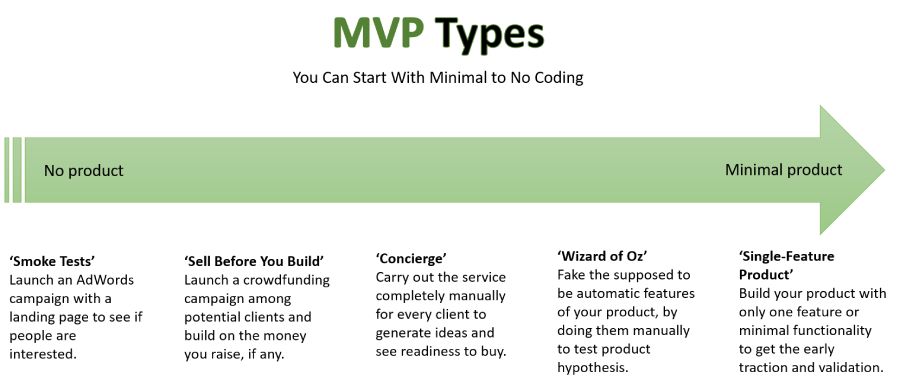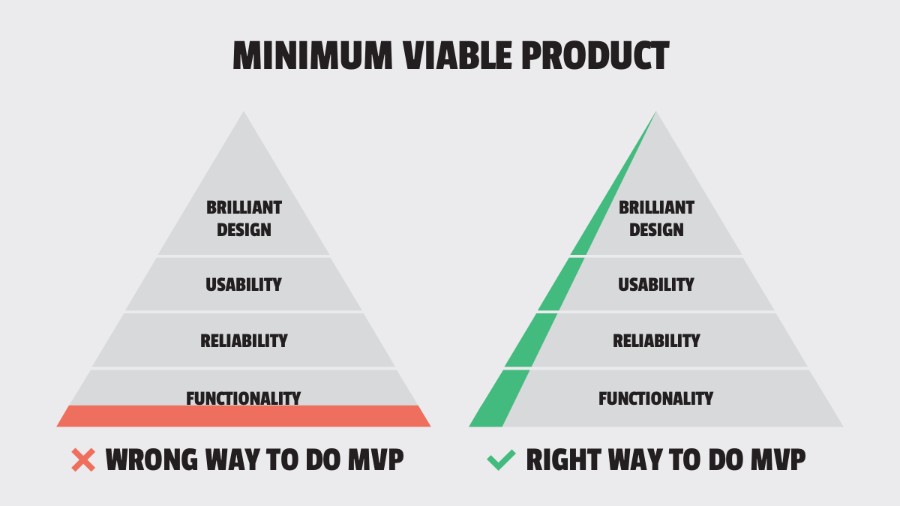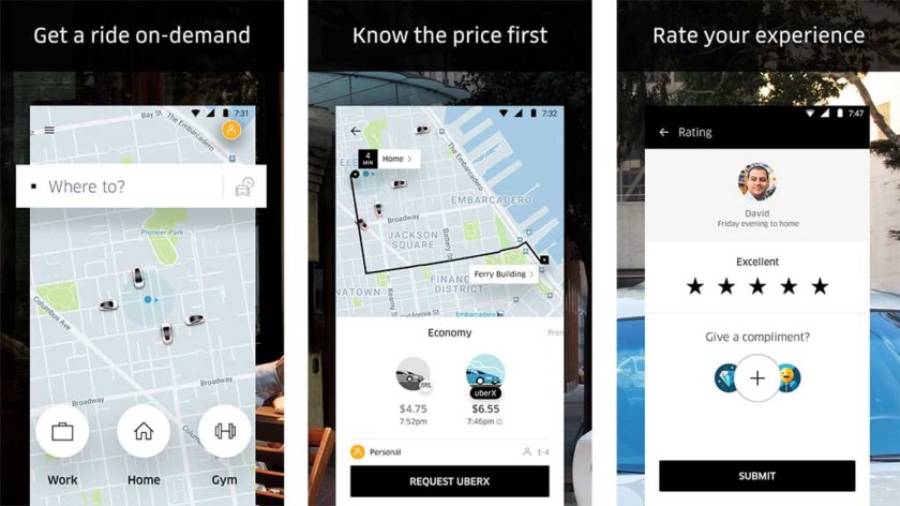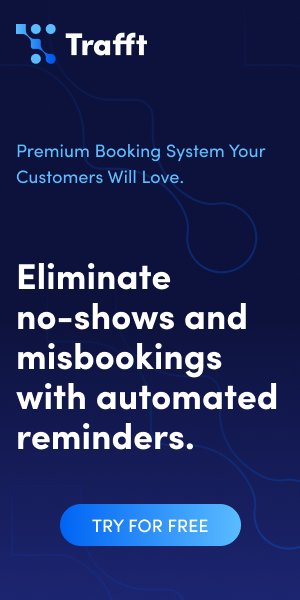8 Steps to Mastering MVP in App Development

Two things make an excellent minimum viable product:
First, it makes customers happy. So happy they’re willing to wait until the final product rolls out.
Second, it relieves customers of a major problem without exceeding your budget.
The question is — how do you do it?
To help you get this right, we wrote this guide as your go-to place for all things MVP in app development.
Among other things, you will learn:
- about different types of MVPs
- how MVP fits in app development
- benefits of using an MVP in app development
- the difference between MVP and a prototype
- how much it costs to build an MVP
- how to avoid common pitfalls of MVP development
Once you read it, you will know how exactly to identify crucial customer pain points and key features you need to offer them.
With this knowledge, you will deliver an economical, functional solution to customers.
And this will help you cement your way to an excellent product.
1. What is an MVP
MVP is short for Minimum Viable Product or in the case of mobile app development Minimum Viable Platform.
It is like a framework, a skeleton of the final product, with features that you will be bringing into play later and aim at providing a better and faster solution to a problem posed by users.
An MVP app focuses on one idea. The goal of an MVP is to release a product that has just enough features to satisfy early customers and provide feedback for future product development.
The key is that you need to be able to sell it or at least go through with a proof of concept. It’s not an MVP until you sell it or test it against the market’s needs.
An MVP allows you to test the market, receive feedback, and then develop your product accordingly.

Types of Minimum Viable Products
The diversity of services and products currently released on the market has created a variety of minimum viable products. Here are the main three types of minimum viable products:
-
The Piecemeal MVP
The Piecemeal MVP uses existing solutions and tools to deliver a product to target users, which makes it a very cost-effective method of presenting a product.
A piecemeal MVP literally consists of components from multiple sources which you are putting together to create a foundation for your product.
The foundation of the piecemeal MVP consists of piecing together its components from various sources. It is a smart way to introduce a product to customers by investing a minimum amount of money in a product.
A classic example of a piecemeal MVP is Groupon – an American marketplace that connects customers with local retailers, travel agencies, grocers, etc.
Andrew Mason started Groupon with a simple WordPress site where he posted deals for a local pizza shop each day, and he generated PDFs manually as he received orders and emailed them via his own personal email.

Source: Groupon
-
The Concierge MVP
The Concierge MVP tests a business idea by providing a man-powered service initially. The idea is to simplify the product by replacing automated components with humans
You create an app that manually solves the customer’s problems, while collecting feedback from customers and analyzing data to understand what your target audience needs before releasing the full app.
With the Concierge MVP, you are directly in touch with your early customers, and get to know your customers and validate your business idea.In this way, you develop your customer base, analyze your audience, and use this information to pivot your concept and redefine your MVP business to better fit .
However, it is not a long-term option, this is just a short-term solution that helps you learn how to solve customer’s problems.
The point of the Concierge, as with most MVP apps, is to maximize learning and mitigate risk of developing a crappy product.
Once the viability of the service is demonstrated, the focus can shift to developing an app that fully automates the entire process, eliminating hands-on aspects.
-
The Wizard of Oz MVP
The Wizard of Oz minimum viable product is a type of MVP that lets users think they are dealing with a full-fledged product although the product is still in the development process.
Unlike the Concierge MVP, the Wizard of Oz MVP focuses on hiding the fact that the product isn’t finished yet.
The idea is to create the impression that your product is the real deal when in reality it’s actually still under development. It is a great way to test a startup that provides services of any kind.
This type of MVP is also referred to as Manual-first MVP or Flintstoning MVP.
-
Smoke Test
A Smoke Test is a type of MVP that tests a hypothesis with a marketing campaign. This is usually done with the landing page strategy we previously mentioned.
The landing page will have some visuals and a description of your product or service, and it will help your future customers see what your product will look like and suggest a simple call to action.
You can offer them the option to sign up for the waiting list, schedule a demo or even buy your product.
And by the end of the smoke test, you are supposed to find out if people are interested in your product or service.
-
Single Feature MVP
Often it’s more effective to test just one essential feature of a product. A Single Featured Minimum Viable Product will prevent users from getting distracted by other features, which will allow you to gain a clear understanding of one specific problem or solution. And it is also more cost-efficient than building a product with many features no-one wants.
-
Sell Before You Build MVP
The idea behind the Sell Before You Build MVP is to pre-sell your app and build it on the money you get. You can do that by launching a crowdfunding campaign on some platform like Kickstarter and try to raise money from your customers.
Fundraising reveals early adopters who will spread the word about your product and provide feedback throughout the product’s development cycle.
The success of such a campaign will also depend on how well you can sell your non-existing app. Sothe first focus would be to work on quality marketing materials.

2. Why you need an MVP for application development
The purpose of an MVP is to launch a product quickly, based on your idea, with a small budget, but there are many persuading reasons to employ an MVP as a product development strategy.
An MVP mobile app is the shortest and most efficient way to develop an idea into a business. It is a starting point for running a successful project. However, it is not a beta version of your app, but a ready-to-use mobile app that offers significant user value.

MVP inputs only the features that you think are the most important and unique, which requires much less time and money.
After launching the MVP, depending on the outcome, you can add new features, improve existing ones or go back to consider your failures and do it all over again.
With this kind of app, you can get a quick market entry and real user experience that will give you an opportunity to assess the potential of a project. And while the early customers are installing your app, you can collect analytical data, measure them, do customer interviews, and get feedback.
Even though “less is more” is true for a minimum viable product, stripping it to the basic features does not mean making a crude product. The MVP needs to be functional in its most basic form, and allow users to test it.
3. Strategies for building an MVP
There are several approaches you can take when building a minimum viable product.
The Landing Page Approach consists of a basic website that has a landing page with details of your concept and a clear call-to-action complemented by an Adwords campaign.
With the Call-to-action, you can go easier by asking them to sign up to a mailing list, or you can be bold and ask them to sign up to buy the product.
Buffer – one of the biggest social media tools, started as just a landing page that showed the idea of Buffer product to visitors with different pricing and features. If somebody was interested, they would choose a plan and get an option to subscribe to the waiting list.

Source:Idea to Paying Customers in 7 Weeks- How We Did It
These emails were used to ask those people about their expectations and features they need. With this approach, they were able to build a product the market actually wanted.
AirBnb also started as a simple web page through which the founders Brian Chesky and Joe Gebbia rented their loft.

The Survey Approach is rarely recommended because surveys are not a genuine minimal viable product.
It can provide some direction but you need to take into consideration that there is a huge difference between what people actually say and what they do. Survey results are very biased, which will considerably differ from the actual MVP results.
The Demo Video Approach can be a good option for an MVP. With this method, you can ask the audience if the solution resonates with their needs upfront.
One of the probably most famous minimum viable products is Dropbox that started as an idea shown through a video. They made a 3-minute video demonstrating full functionality, which was enough for them to receive great user feedback and get the necessary funds for development.
Drew Houston spent years building a minimum viable product that has now developed into a powerful app and tool people today use. By using a video, they saved themselves from spending thousands of dollars irrationally and got excellent results that pushed them to go into production.

4. Benefits of Building an MVP app
An MVP allows companies or entrepreneurs to launch a product with the core proposition that will help them see if the app can catch the attention of possible contributors and investors.
Here are some of the benefits of launching a minimum viable product to test your business idea and product concept before building your final product:
- An MVP will allow you to make your product available sooner rather than later
- Releasing it will bring down implementation-related costs
- With a minimum viable app, you will be able to identify and quantify the demand that is related to your product
- A minimum viable app will help you avoid potential financial losses
- It makes you aware of the pros and cons of your product
- Direct buyer collaboration with an MVP provides a detailed evaluation and understanding of their partialities and behaviors.
- Launching an MVP will enhance the collection of data for a more expansive database
- An MVP is also a chance to come up with new, exclusive concepts
- It avoids spending all of your resources right away, on things that may not work.
5. Prototype vs MVP
During your app development plan, at one point you need to choose between methodologies to use – prototype and minimum viable product (MVP). Even though both are often bundled together, they are different things that can either be used together or separately.
The main difference between a prototype and an MVP is viability. Unlike a prototype or concept test, a minimum viable product is made to answer product design and technical questions, with the goal of testing fundamental business hypotheses.
A prototype can even be a drawing on paper, while an MVP has to be able to do the primary function of your app.
Let’s take a closer look at both methodologies and their purposes.
Prototype
- Goal: Get a glimpse and feel the app
If you look up the word prototype in the Oxford English Dictionary, you will find it listed as “a first or preliminary version of a device or vehicle from which other forms are developed.”
A prototype is an early sample, model, or release of an app that was built to test a certain process or concept, and serve as something that can be replicated or learned from. It is essentially a visual representation of what a software product will look like.
The main purpose of a prototype is to test feasibility and proof of concept, with the focus of presenting it to stakeholders and designing it for a very small audience. You can present an idea for investors and potential users, without having a functional app yet.
With the help of the prototype, users and stakeholders can see and possibly interact with the working model of the app idea and get a preview of how the end result will look. However, the prototype can contain many bugs and issues, because the aim is just to see how the idea is operating in real-time performance.
Making a prototype is beneficial because it will be cheaper to make changes to user interface and user experience than with a real application. After testing, a prototype is discarded.
MVP
- Goal: Build and test core features
A minimum viable product is a basic app that revolves around one core feature. It is basically a development technique where you develop an application or a website with sufficient features that will satisfy early users.
The main purpose is to maximize validated learning for the least effort, with a focus on deployment into production for sizable customer groups.
After testing, app MVP is not discarded, but instead, it is used to create the first version of a complete solution. The final, complete set of features is only designed and developed after considering the feedback from the product’s initial users.

Source: SparkSolutions
6. How much does it cost to build an app MVP
Building an MVP will be much cheaper than developing a full app. The average cost to develop a minimum viable product will depend on the kind of solution you plan to implement and which way you want to build it.
There are several ways you can build a minimum viable product app – you can hire a developer to work internally, outsource it to a freelance developer, or a software engineering company.
The cost largely differs based on who is building it. If you hire a freelancer, he may charge you around $5,000 to $15,000, depending of the scope of the project, while a company with an experienced team of developers would charge between $30,000 and $60,000, depending on the company and the scope of work.
But, ultimately, the cost will depend on the type of MVP app you want to build, the design you want to use, and the technology it requires.
7. Is it better to build web app MVP or mobile app MVP?
Before building an MVP, it is important to figure out if you need a web or mobile app. In some cases, the answer will be obvious.
For example, if you need to use a GPS or a camera, the obvious solution would be to make a mobile app. But if you plan to create an app for internal company use, for the means of tracking or inventory, then a web app is a better choice.
Apart from the obvious one, there are also a number of reasons why you might choose one over the other.
If you are building your first MVP in a short period of time, a mobile app may be the right choice. However, mobile apps might require different versions for each app store that you want to submit to, which also means testing and iterating multiple versions.
So, if you do not need the app right away, or you have limited development budget, building a web application would be a better choice.
But keep in mind that building a mobile MVP will allow you to test your idea with a larger audience segment. After all, users feel more encouraged to try a new app.
8. How to Build an MVP in App Development the Right Way?
After establishing all the important details about a minimum viable product, let’s review the steps you need to take to build it.
Identify the crucial pain point
Before building an MVP, you need to figure out the problem you want to solve, and for whom you are solving it.
Some entrepreneurs choose to release an MVP with many features that drive the focus away from the primary characteristics, which often leads to failure and capital loss.
However, others are too enthusiastic in trimming their MVP, and because of that they get rid of its fundamental features in the process.
A good way to start is by asking yourself two questions to put you in the customer’s shoes:
- Why do I need this product?
- How can the product help me?
By answering these questions, you will get some insight into the main goal of your product, and with it, you can find the best solution for your future customers’ needs.
Those future customers are your target audience that will buy and use your product, so you need to find a problem you can solve for them.
To do that, you could think about your personal challenges and about something you could personally do better with the right tool.
Let’s take Uber as an example. Uber started as an app through which you could only request premium black cars in a few metropolitan areas. But it was not expensive because it was aimed at people who couldn’t afford to order a premium black car from a traditional taxi service.
Just like that, you can find a problem within a particular segment of the market and offer a solution.

Find out what the competition is doing wrong
It goes without saying that you need to conduct a competitor analysis and find if there are any similar products on the market.
Many have too much faith in their product’s uniqueness, so they ignore competitor analysis. But it is necessary if you want to confidently bring your product to the market.
After determining what our idea is, we like to find something new that our product will place, something that will make us better than the competitors.
There are many different tools you can use to research your competitor’s websites or apps. You can also find and analyze feedback about your competitors’ products.
Determine your feature(s)
Start with defining the main feature – the single-most important action that you want users to carry out. Of course, the main feature will not be the only one – you also need to define other features that you want to offer. However, not all features are necessary for your MVP.
At TMS after we define our broader scope of features, we like to divide them into four categories: Must have, Should have, Could have, and Won’t have. These are the principles of the MoSCoW technique that has helped with our development process many times.
Our MVP is based on the features in the Must have and Should have lists, but that also depends on the industry. Sometimes you can make a bare minimum MVP with one, but other times it is necessary to make a few features.
When you’ve prioritized all the features, you may define their scope for the first version of the product and move to build an MVP.
For the items in the two categories, we do an evaluation of the technical complexity, business risk, business value, and dependency estimation.
Additionally, at the very start of the development, we also like to go over a few things:
- Impact mapping – This strategic planning technique prevents organisations from getting lost during their product development. It involves us setting our goal when we want to launch or sell the product and then we draw a map with everything that can impact the process, how much it can interfere and how it helps with the prioritization of the effort.
- Story mapping – We take user stories and make a backlog for the development team. The map arranges user activities in rough order of priority – in which you would describe activities to explain the behaviour of the system.
- Design sprint – It is a five-day process for answering critical business questions through design, prototyping, and testing ideas with customers.
Define user actions for reaching the goal
After determining the features that will be used, you need to define the process stages. Each stage needs to have a list of particular features. You need to explain the steps required to reach your product’s primary goal, focusing on the basic tasks.
For each stage, you need to define the basic tasks, and for each of those tasks, you will define a feature. Let’s say you are making an app for an online store. The basic tasks would be “find,” “buy,” “manage orders,” and “receive orders.”
Build and Test
After everything has been planned and the first scope of work is defined, your app can go into the development stage.
Before the product development is completed, the product needs to be tested. The initial testing stage needs to be done by Quality Assurance engineers, who will keep improving the product before release.
With the feedback you receive, you can implement some changes in the future versions of your product.
The QA Engineers will release the app for alpha or beta testing. Alpha testing is when you give an alpha build of your product to a limited focus group, while beta testing means that the product will go out into the real world to be tested by real users.
But, in my opinion, when the product enters beta testing, it is more than just an MVP – it becomes a Beta version.
Conclusion
The success of any start-up business often depends on a minimum viable product. New companies opt in favor of an MVP just because it means a minimum investment, protects them from potential capital losses and can endorse their business concept.
A lot of today’s successful businesses, including Uber and Dropbox, have penetrated their target markets via an excellent minimum viable product. These facts reinforce once again the value of an iterative approach that puts the customer and its needs first.
The goal is to develop a product that makes customers happy, a product that makes them join a huge waiting list before it is even finalized. You can cater to the technical feasibility aspects after you are sure a large audience wants your product.
The important thing is that the MVP does not need to have too many nice-to-have things. After all, if you’re not embarrassed by the first version of your product, you’ve launched too late.
If you need help with launching your app as a minimum viable product, feel free to reach out to us.
